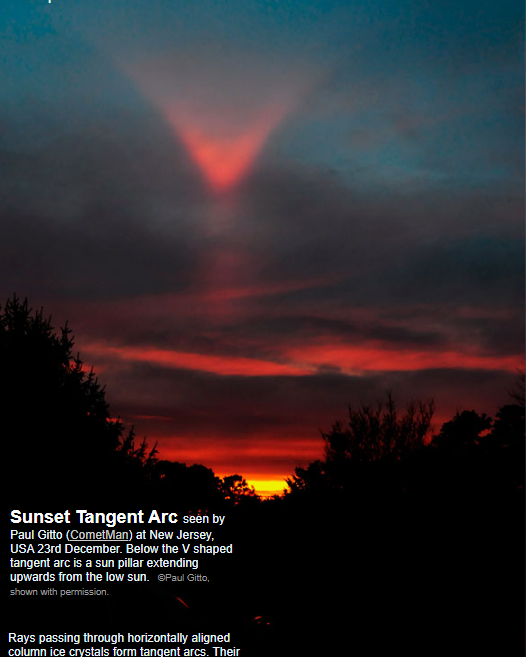OPOD - Red Tangent Arc
OPOD - Red Tangent Arc: A Fascinating Atmospheric Phenomenon
Have you ever witnessed a mesmerizing display of colors in the sky during sunset? One such captivating sight is the red tangent arc, an atmospheric optical phenomenon that occurs when sunlight passes through horizontally aligned column ice crystals. In this blog post, we will delve deeper into the intricacies of the red tangent arc and explore its unique characteristics.
The Basics of the Red Tangent Arc
The red tangent arc is a type of tangent arc that forms when rays of sunlight pass through column-shaped ice crystals that are aligned horizontally in the atmosphere. This phenomenon causes the lower tip of the arc to always be positioned 22 degrees away from the sun, touching the 22-degree circular halo if present. These ice crystals act as prisms, refracting and reflecting sunlight to create a stunning display of colors.
The Changing Shape of the Red Tangent Arc
One of the most fascinating aspects of the red tangent arc is its shape, which undergoes dramatic transformations as the sun climbs higher in the sky. Initially, when the sun is at a low position, the tangent arc appears V-shaped. However, as the sun rises, the V gradually opens up, resembling the wings of a seagull. Eventually, the upper tangent arc merges with its lower counterpart, forming a complete circumscribed halo.
The Colorful World of Tangent Arcs
While all tangent arcs exhibit colors, the red tangent arc specifically showcases highly reddened hues of the sun. This vibrant display is a result of the scattering and absorption of light by the ice crystals in the atmosphere. As sunlight passes through these crystals, it undergoes dispersion, separating into its constituent colors. The longer wavelengths, such as red and orange, dominate the scene, creating a striking visual spectacle.
The Magic of Sunset Tangent Arcs
The red tangent arc is often observed during sunset, adding an extra touch of magic to the already enchanting moment. As the sun descends towards the horizon, its light must pass through a larger portion of the Earth's atmosphere. This increased atmospheric path length causes more scattering and allows for a greater display of colors. The combination of the setting sun, the tangent arc, and the surrounding atmospheric conditions creates a truly captivating experience.
Exploring the Phenomenon Further
If you're intrigued by the red tangent arc and want to learn more about atmospheric optics, there are various resources available to expand your knowledge. Websites like Atmospheric Optics provide a wealth of information, including photographs, explanations, and scientific insights into different atmospheric phenomena. Additionally, you can explore books and scientific papers written by experts in the field to gain a deeper understanding of these captivating optical phenomena.
Capturing the Beauty: Photography Tips
Photographing the red tangent arc can be a rewarding experience, allowing you to preserve the awe-inspiring beauty of this atmospheric phenomenon. Here are a few tips to help you capture its essence:
- Choose the right time: The best time to photograph the red tangent arc is during sunset when the sun is at a low position in the sky.
- Find a clear view: Look for a location with an unobstructed view of the horizon to capture the full extent of the arc.
- Experiment with angles: Try different angles and perspectives to capture unique compositions and emphasize the arc's shape and colors.
- Consider using filters: Utilize filters, such as polarizing filters or graduated neutral density filters, to enhance the contrast and saturation of the colors in your photographs.
Conclusion
The red tangent arc is a captivating atmospheric optical phenomenon that adds a touch of wonder to our sunsets. Understanding its formation and characteristics allows us to appreciate the intricate beauty of nature's display. Whether you're an avid sky watcher or a photography enthusiast, witnessing and capturing the red tangent arc is an experience that will leave you in awe of the wonders that exist above us. So, next time you find yourself gazing at a stunning sunset, keep an eye out for the mesmerizing red tangent arc and let yourself be transported into a world of vibrant colors and ethereal beauty.

Sunset Tangent Arc seen by Paul Gitto (CometMan) at New Jersey, USA 23rd December. Below the V shaped tangent arc is a sun pillar extending upwards from the low sun. ©Paul Gitto, shown with permission.
Rays passing through horizontally aligned column ice crystals form tangent arcs. Their lower tip is always 22 degrees from the sun and touches the 22 degree circular halo when the latter is present.
Tangent arc shapes change dramatically as the sun climbs. At low sun they are V shaped. As the sun climbs the V opens up until eventually the arc resembles a gull's wings. Eventually the upper tangent arc joins its lower counterpart to form a circumscribed halo.
Tangent arcs are coloured. This one shows only the sun's highly reddened hues.

Note: this article has been automatically converted from the old site and may not appear as intended. You can find the original article here.
Reference Atmospheric Optics
If you use any of the definitions, information, or data presented on Atmospheric Optics, please copy the link or reference below to properly credit us as the reference source. Thank you!
-
<a href="https://atoptics.co.uk/blog/opod-red-tangent-arc/">OPOD - Red Tangent Arc</a>
-
"OPOD - Red Tangent Arc". Atmospheric Optics. Accessed on November 24, 2024. https://atoptics.co.uk/blog/opod-red-tangent-arc/.
-
"OPOD - Red Tangent Arc". Atmospheric Optics, https://atoptics.co.uk/blog/opod-red-tangent-arc/. Accessed 24 November, 2024
-
OPOD - Red Tangent Arc. Atmospheric Optics. Retrieved from https://atoptics.co.uk/blog/opod-red-tangent-arc/.